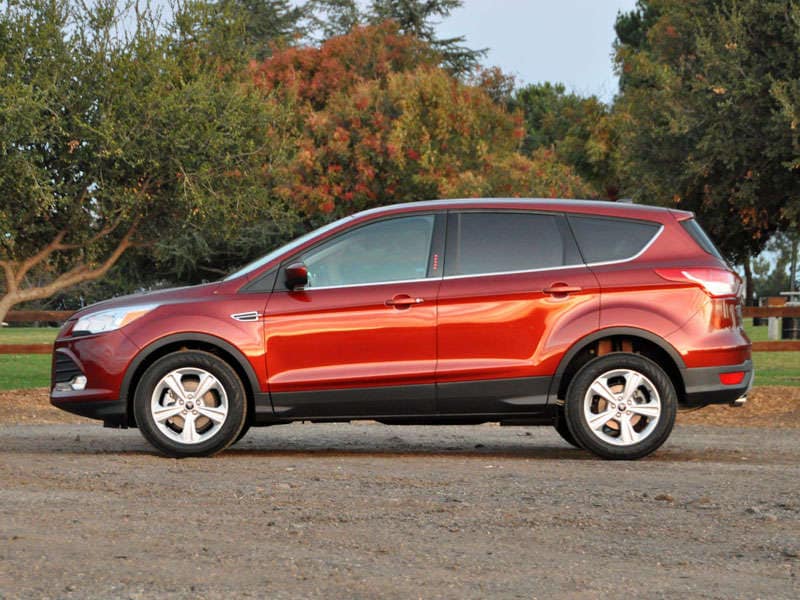Recent Articles
Popular Makes
Body Types
2014 Ford Escape Road Test and Review
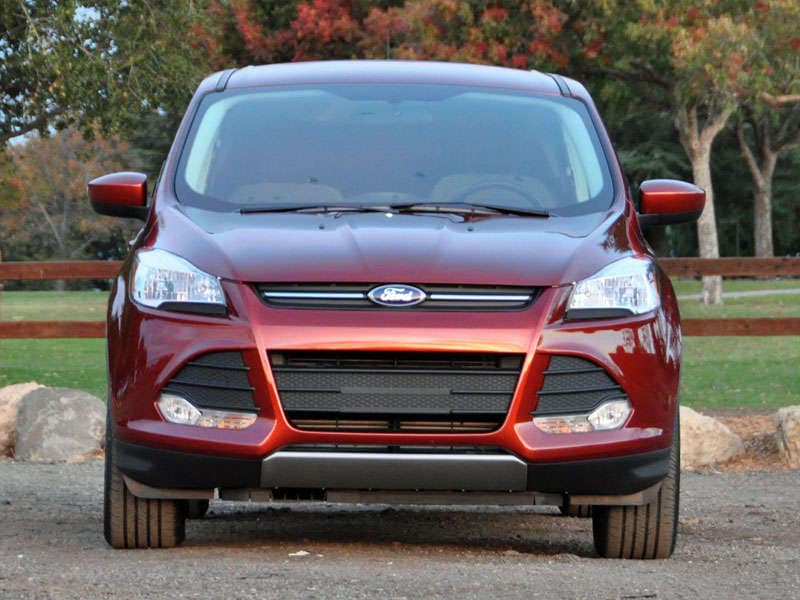
Ford is going to sell 300,000 examples of its Escape compact crossover SUV in the U.S. this year, making it one of the best-selling vehicles in America despite a rash of recalls, despite a lousy crash-test rating in a tough new test, and despite unimpressive showings in benchmark customer satisfaction surveys regarding quality, reliability, performance, and design. Granted, lots of those Escapes are landing in rental car lots and business fleets, where they serve hurried travelers and mall security guards alike. But lots of those Escapes are also getting parked in driveways all across the country, too, which might lead you to conclude that people don’t do much research before buying a new vehicle.
Given the Ford Escape’s popularity, and because I hadn’t driven one since the completely redesigned model debuted for 2013, I figured I’d better spend some quality time with the Escape to determine whether or not it is worthy of your consideration, especially in a vehicle class filled with alternatives such as the Chevrolet Equinox, GMC Terrain, Honda CR-V, Hyundai Tucson, Kia Sportage, Mazda CX-5, Mitsubishi Outlander, Nissan Rogue, Subaru Forester, Toyota RAV4, and Volkswagen Tiguan.
2014 Ford Escape Road Test and Review: Models and Prices
Ford sells the 2014 Ford Escape in S, SE, and Titanium trim levels. Last year’s SEL model has been discontinued, its equipment now offered as options for the mid-grade SE variant.
For 2014, the Escape S is priced at $23,595*. Offered only with front-wheel-drive, a 2.5-liter 4-cylinder engine, and a restricted number of paint colors combined with black cloth seats, few options are available for the Escape S. Load one up with all factory-installed extras, and it costs $24,390.
This lack of variety in terms of equipment is one reason why the Escape SE is the most popular version of Ford’s compact crossover SUV, and because the SE model is the most popular, Ford scheduled this version of the Escape for my evaluation. Prices start at $26,445, and buyers choose between two turbocharged 4-cylinder EcoBoost engines and decide whether or not they want all-wheel drive.
The Escape SE is also available in more colors, inside and out, and additional standard equipment for the Escape SE includes 17-inch aluminum wheels, a 10-way power driver’s seat, satellite radio, a compass, an exterior temperature display, a rear center armrest with cupholders, upgraded interior and exterior trim, dark tinted rear privacy glass, automatic headlights, fog lights, and a Securi-code invisible keyless entry keypad for the driver’s door. Load one up with all the extras, and the price rises to more than $33,000.
If you think that’s steep, check out the fancy Ford Escape Titanium. It starts at $29,995, and rises to $35,925 with all the factory upgrades. Include all of the dealer-installed extras, and this version of the Escape prices out north of $37,000. In terms of standard equipment, the Escape Titanium adds the following items to the Escape SE: leather seats and trim, dual-zone automatic climate control, a premium audio system, a MyFord Touch infotainment system, Intelligent Access keyless passive entry with push-button ignition, and a foot-operated power liftgate design. Additionally, the Titanium is equipped with remote engine starting, a universal garage door opener, an auto-dimming rearview mirror, a 110-volt power outlet, ambient cabin lighting, puddle lamp exterior lighting, turn signal indicators for the heated side mirrors, rear parking assist sensors, and 18-inch aluminum wheels.
As mentioned above, I test-drove the Escape SE model, painted in a new color called Sunset. It had front-wheel drive, the standard 1.6-liter EcoBoost engine, and no options. The price tag was $26,445.
* All prices include a destination charge of $895
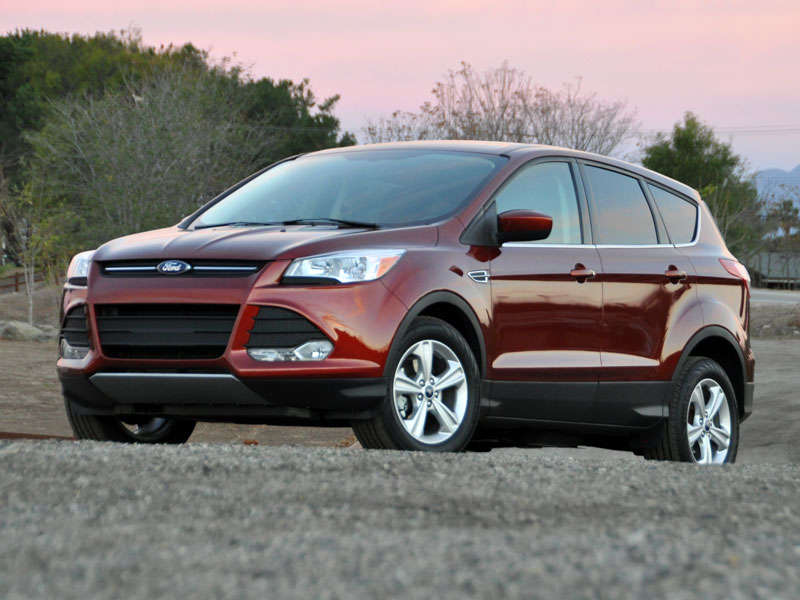
2014 Ford Escape Road Test and Review: Design
- No changes
Inside and out, it is clear that the 2014 Ford Escape is patterned after the same stylistic themes governing the design of the Fiesta, Focus, and Fusion. This heavily stylized SUV is modern in appearance, but is equipped with unfortunate garnishments like silver “skid plates” and chrome “fender vents” to add what I’m sure someone considers to be a more rugged and sporty look. The Escape’s new Sunset paint glows orange in rising or setting sunlight, but otherwise looks like a burnt red color.
Inside, the Escape SE presents a technical design with futuristic italicized gauge markings and infotainment controls originally designed to resemble a flip phone. Remember those? So 2005. Softly padded material covers the Escape’s dash pad, upper door panels, and arm rests, and the 2-tone fabric seats feel durable and look stylish with exposed contrast stitching and a horizontal stripe on each seatback.
From my perspective, certain control markings are not easily recognized or understood, though with practice using the steering wheel and infotainment system becomes easier. Really, though, Ford needs to redesign the Escape’s standard stereo setup in favor of a more conventional approach.
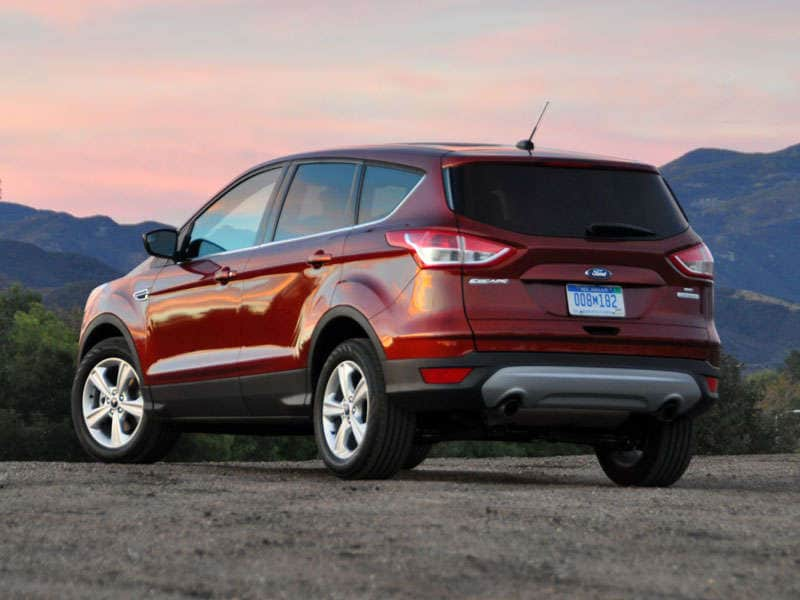
2014 Ford Escape Road Test and Review: Comfort and Cargo
- Power liftgate option now offered in conjunction with towing equipment
If you’re riding in the Escape’s front seats, you’ll be comfortable. In the SE model, the driver’s seat provides 10-way power adjustment including lumbar support, combined with a 4-way adjustable headrest and a tilt/telescopic steering wheel. The result, if you choose it, is a tall driving position with a good view out. And don’t forget that the upper door panel trim, the door panel armrests, and the center console armrest are all softly padded for extra comfort.
The front passenger’s seat lacks the adjustability of the driver’s seat, but is nevertheless comfortable. It sits high enough off of the floor to provide a decent view out, and even if the occupant has longer legs the seat can easily slide forward to provide extra rear seat space when necessary.
Adults riding in the Escape’s firm, flat, and low rear seat will certainly appreciate this flexibility. Leg space is tight, but the front seatbacks are soft and kind to knees and shins. Plus there’s plenty of space under the front seats for feet. The rear seatback does recline a bit, but I didn’t see how that added to comfort. Note that my older daughters, now teenagers, both complained about riding in the Escape due to comfort issues.
Using the Escape to transport younger kids isn’t necessarily easy, either. My 5-year-old had lots of trouble buckling the seatbelt when using her booster seat, the base of which partially covered the seatbelt anchor. Even my wife and I struggled to get things latched down properly.
Installing my 3-year-old’s forward-facing child seat was also difficult. The bottom anchors and straps were quickly and easily cinched, but the top strap needed to go over the large rear seat headrest and, when fully extended, just reached the rear anchor point. Plus, flaps designed to cover gaps in the floor when the rear seat is folded down made getting the latch itself on and off of the anchor hook difficult at best.
As for storage, the Escape offers a tray atop the dashboard, a deep two-tier glove box, door panel bins, and a very deep but very narrow center box where the USB port and auxiliary audio input jack are located. Cargo space measures 34.3 cu.-ft. with the rear seat in use. To expand room, fold the head restraint and release a lever to fold the 60/40-split rear seatbacks down. The result is 67.8 cu.-ft. of space, less than several of the Escape’s competitors.
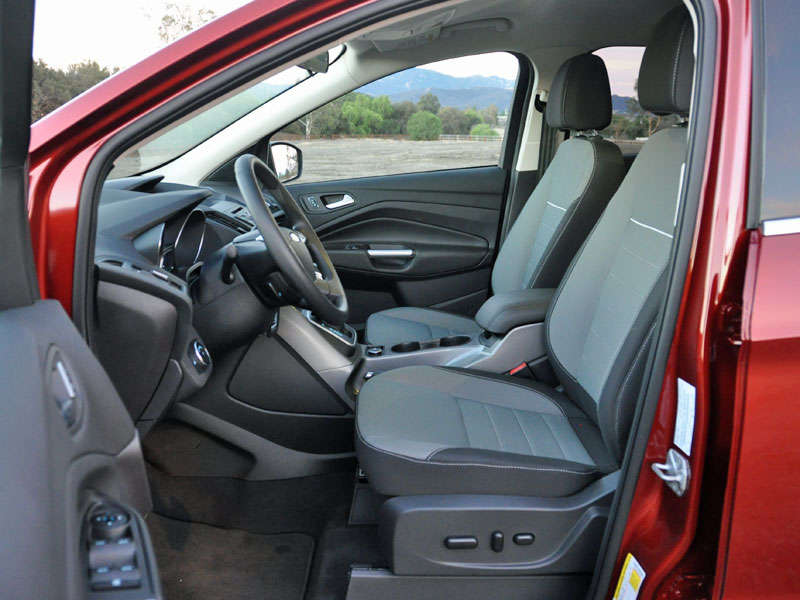
2014 Ford Escape Road Test and Review: Features and Controls
- No changes
As I alluded to earlier in this review, there’s plenty of weirdness inside the Ford Escape, but then I think the exact same thing every time I step into a modern art museum, so take such criticism with a grain of the proverbial salt.
In any case, the Escape’s sometimes cryptic controls take some getting used to, especially those mounted to the steering wheel and the buttons for the infotainment system. These are the same controls required to use Sync, and their design, combined with sometimes unclear instructions on the small display screen and my test vehicle’s lack of Bluetooth music streaming capability, made it harder to pair a smartphone and play music. Again, with acclimation, this all gets easier, but I’ve been in some vehicles where the pairing process is as easy as making my phone discoverable and the technology takes care of everything else.
Here’s another thing that’s strange about the Escape. After dark, the interior controls are illuminated even when the headlights are not. This is a bad idea, Ford. Someone from product planning needs to hang around in West Los Angeles, Santa Monica, or Malibu on a summer night to see the numerous Focus and Escape rentals rolling down the 405 freeway or the Pacific Coast Highway piloted by clueless tourists who don’t realize that only their daytime running lights are on.
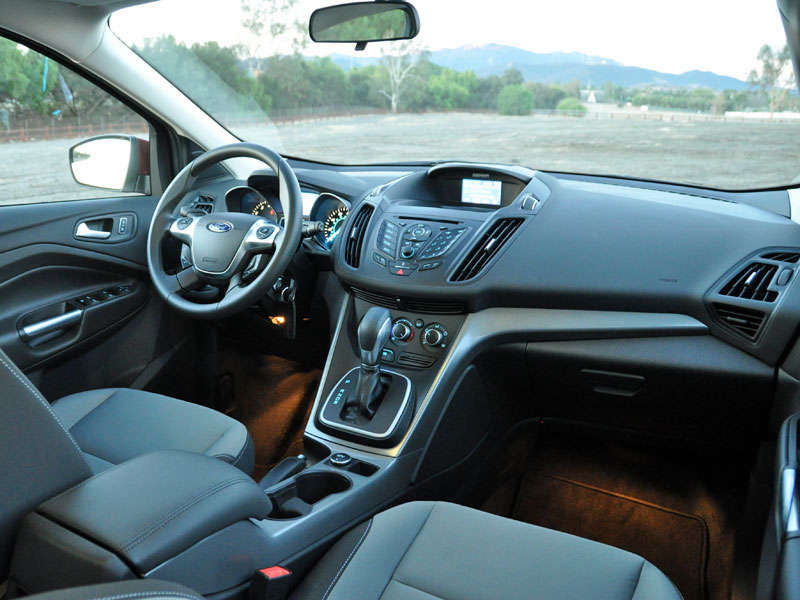
2014 Ford Escape Road Test and Review: Safety and Ratings
- No changes
When it comes to safety, every 2014 Escape is equipped with spotter-style side mirrors, a Curve Control system to help stabilize the SUV in corners, MyKey programmable vehicle features related to speed and seat belt usage, and Sync connectivity with 911 Assist technology that helps to summon rescuers following an airbag deployment. My Escape SE test vehicle also came with a reversing camera, the display for which is small and far away but features extraordinary resolution.
In addition to these features, the Escape SE is available with reversing sensors that come standard for the Escape Titanium, while the Titanium model can be optioned with a blind spot information system, a rear cross traffic alert system, and rain-sensing wipers.
Generally speaking, the 2014 Escape gets decent crash-test ratings. In tests conducted by the National Highway Traffic Safety Administration (NHTSA), the Escape receives an overall rating of 4 stars, but doesn’t achieve less than a 4-star rating in any individual assessment.
The Insurance Institute for Highway Safety rates the Escape as “Good” in most evaluations. The exception is the “Poor” rating the SUV received in the difficult new small overlap frontal-impact test, which measures performance in the event the vehicle hits a tree, a pole, or oncoming traffic on the left front corner.
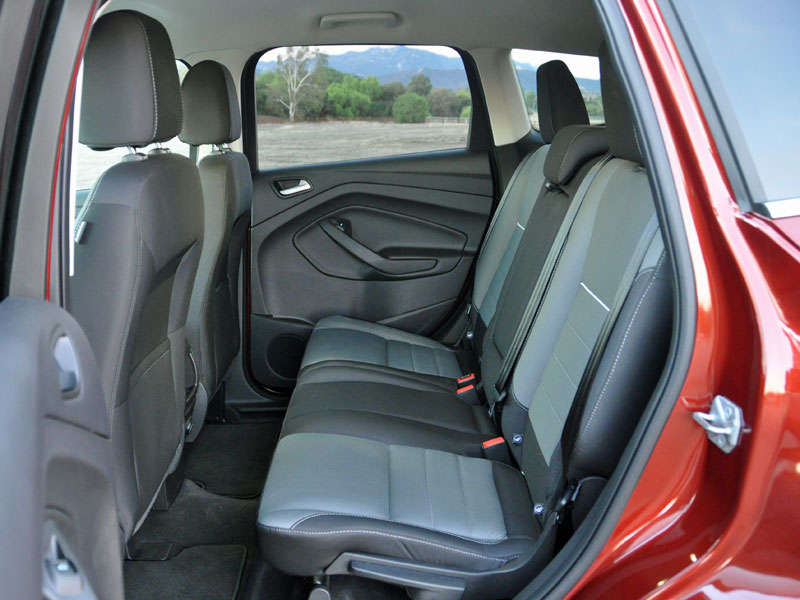
2014 Ford Escape Road Test and Review: Engines and Fuel Economy
- No changes
Ford Escape buyers have a choice between three engines. The base Escape S is equipped with a 168-horsepower, 2.5-liter 4-cylinder engine, a 6-speed automatic transmission, and front-wheel drive.
People seeking the Escape’s optional all-wheel-drive system with torque vectoring control must choose the SE or Titanium model, each of which is offered with a standard 178-horsepower, 1.6-liter EcoBoost 4-cylinder engine that is turbocharged and makes its 184 lb.-ft. of torque across a broader part of the rev range. Front-wheel drive and a 6-speed automatic transmission are standard for these versions of the Escape.
Available as an option, paired with either front-wheel or all-wheel drive, a turbocharged 2.0-liter EcoBoost 4-cylinder engine generates 240 horsepower and 270 lb.-ft. of torque, 62 more horsepower and 86 lb.-ft. more torque than the 1.6-liter EcoBoost engine. It also has a 6-speed automatic transmission.
My test vehicle had the 1.6-liter EcoBoost engine and front-wheel drive, making it the most fuel-efficient version of the Escape’s multiple powertrains. According to the EPA, my Escape should have returned 23 mpg in the city, 32 mpg on the highway, and 26 mpg in combined driving.
Based on my experience, those numbers are inaccurate. For the entire week of mixed driving, my test vehicle averaged 23.2 mpg. Digging deeper into my data, it would appear that the EPA’s city fuel economy number is optimistic, as my testing in that environment produced 17.2 mpg. On the highway, I was able to get 33.5 mpg.
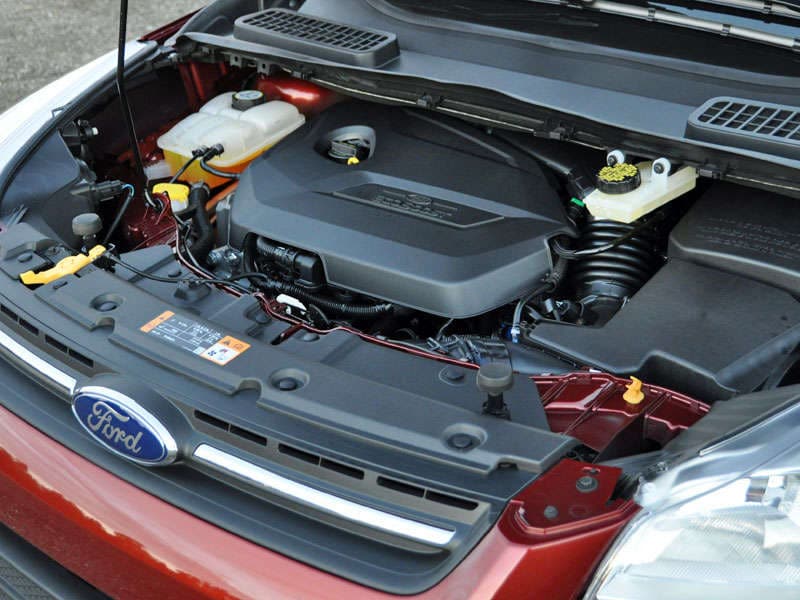
2014 Ford Escape Road Test and Review: Driving Impressions
Ford’s EcoBoost engine program aims to prove that there is a replacement for displacement, and its called turbocharging. From the Fiesta EcoBoost and its tiny 1.0-liter 3-cylinder engine to the F-150 EcoBoost and its torque-rich 3.5-liter twin-turbocharged V-6, each application of EcoBoost delivers the power of a larger engine combined with the fuel economy of a smaller engine. That’s the theory, anyway.
As applied to the 2014 Ford Escape, I found that the 1.6-liter EcoBoost 4-cylinder provides just enough torque across a broad enough range to make the Escape feel quick and lively around town. As the SUV approaches prevailing freeway speeds near the bottom of an on-ramp, though, it feels winded, like it’s already giving all it’s got. Keep in mind, too, that a turbocharged engine is less susceptible to the effects of altitude on an engine, helping it to perform better in places like Denver compared to an engine without a turbocharger.
Go light on the accelerator, and you’ll find that the Escape’s 6-speed automatic transmission upshifts rapidly in order to conserve fuel. A Sport mode holds revs a bit longer, and there is a button on the side of the gear selector that allows for manual control over gear selection. This video-game-style arrangement isn’t as pleasing to use as a separate shift gate or paddles on a steering wheel. Admittedly, it will never occur to most Escape owners to manually choose their gears, but I live in a mountainous region, and I prefer using the transmission and engine braking on descents rather than just the brakes.
Furthermore, when shifting into Drive, I regularly and mistakenly put the Escape into Sport mode, and after purposely choosing Sport mode for engine braking I would forget I was in that gear (which contributed to lower fuel economy, no doubt). In my opinion, the Sport model should be a more deliberate and obvious choice, and gear changes ought to be executed using a gate or paddles instead of a rocker button on the side of the shifter.
Also, I noticed that when the transmission was placed in regular Drive mode the Escape wouldn’t easily respond to pedal input with a downshift when exiting a turn. I’m sure this has to do with maximizing gas mileage, but at the same time technology exists that allows the transmission to choose gears based on braking, acceleration, steering angle, and yaw rates in order to best match performance with driver intent. Ford might wish to consider adding such technology to the Escape.
When I first started driving the Escape, I needed to train myself to bring my foot higher off of the gas pedal before switching to the brake pedal because the brake sits high in relation to the accelerator. Until I had done that, I kept catching the side of my foot under the brake pedal. Once acclimated, it is clear that the Escape’s brakes bite instantaneously, and offer impressive levels of finesse as the driver adjusts pressure. They do take some getting used to, but then they work quite effectively.
Ford’s electric steering has, traditionally, been among the best in the industry thanks to its ability to resist road crowns and combat crosswinds. Lately, it is clear that competitors are catching up, and as a result the Escape’s tiller felt a little lifeless to me. The wheel itself is pleasingly shaped and pleasant to grip, designed to encourage 10-and-2 hand positions, but on-center connectedness and off-center effort levels felt more artificial than expected.
Thanks to Euro-influenced suspension tuning, the Escape provides a taut ride quality and does a great job of communicating both texture and tone from the tires’ contact patches. It is easy to drive the Escape swiftly on a favorite back road, the SUV’s Curve Control technology working in quiet, subtle fashion to eradicate oversteer and understeer. You sit tall behind the steering wheel, and you can definitely feel the Escape’s body rolling when pitching it into a turn, but the 17-inch wheel/tire combo delivers good grip and the Escape never reacts to driver input in a sudden or unexpected fashion.
Dynamically, this is an accomplished crossover SUV, one suffering from a hint of wind noise at highway speeds and, on certain paved surfaces, significant road rumble. But these traits are not uncommon in the class.
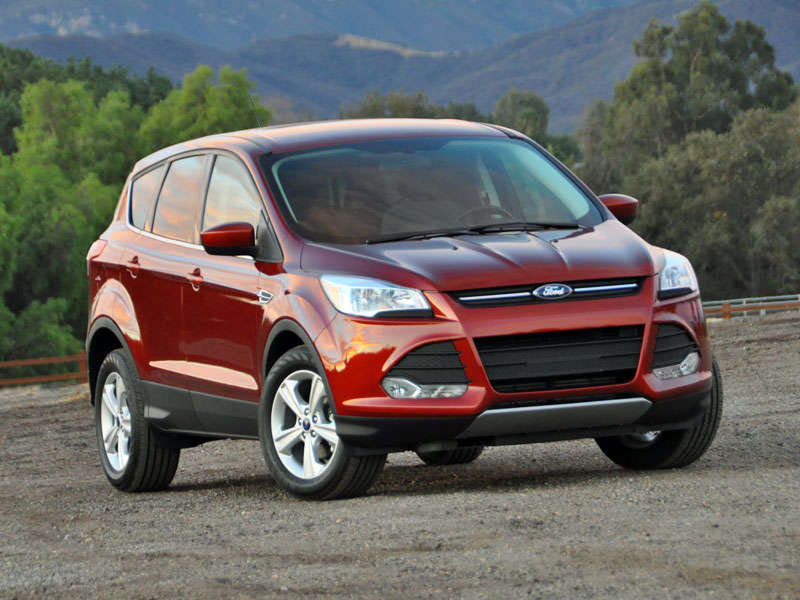
2014 Ford Escape Road Test and Review: Final Thoughts
Frankly, it would appear that Ford has some work to do in terms of improving the recently redesigned Escape. The week I had the 2014 model parked in my driveway, Ford announced yet another recall for nearly 150,000 examples of the 2013 Escape in order to resolve more potential engine fire concerns with the 1.6-liter EcoBoost engine. Certainly, that will not help with regard to those Consumer Reports and J.D. Power ratings. Ford also has not announced changes to address that “Poor” crash-test rating from the IIHS. And while Escape owners report impressive fuel economy figures to the EPA, in my experience the SUV came up short in terms of gas mileage. These flaws are related to fundamental reasons that consumers will either choose or reject a particular model: reliability, safety, and fuel efficiency.
Nevertheless, elements of a competitive crossover SUV are present in the 2014 Escape. It drives like a car, while providing the outward visibility of a truck. Optional AWD helps drivers battle snowstorms, and buyers can choose to equip an Escape with features that aren’t found on competing models. Comfortable front seats, quality cabin materials, and a usefully shaped cargo area all make the Escape appealing. With some attention to the fundamentals, Ford can count on moving hundreds of thousands of them each year for a long time to come.
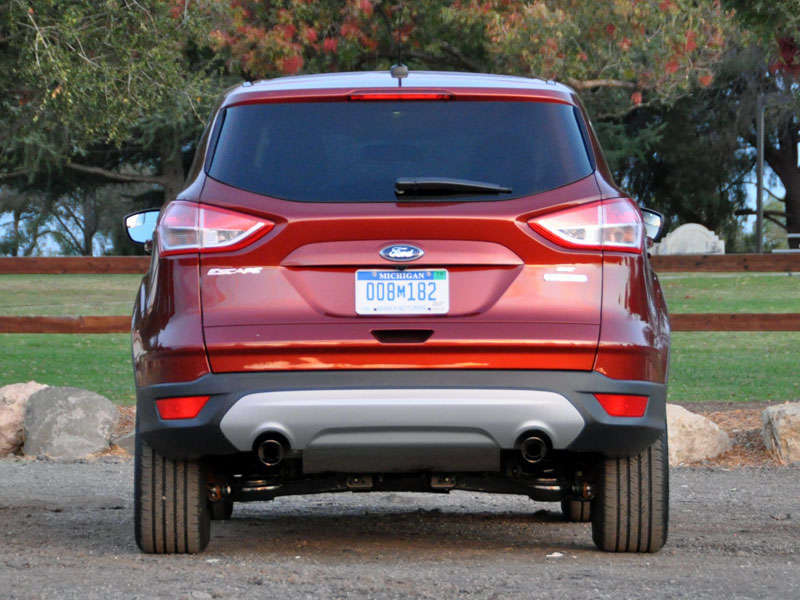
2014 Ford Escape Road Test and Review: Pros and Cons
- Zippy engine
- Athletic handling
- Comfortable front seats
- Quality interior materials
- Impressive standard and optional safety features
- Offers plenty of choice in terms of equipment
- Observed fuel economy
- Uncomfortable rear seats
- Unfriendly to child seats
- Confusing control layout
- Sync-ing takes practice
- Funky headlight operation
Ford supplied the vehicle for this review
2014 Ford Escape photos by Christian Wardlaw
